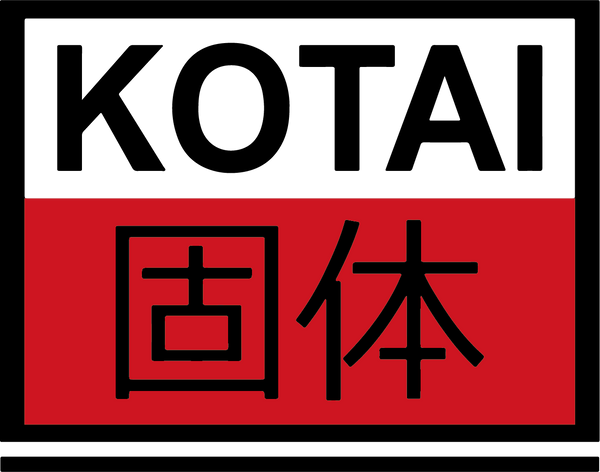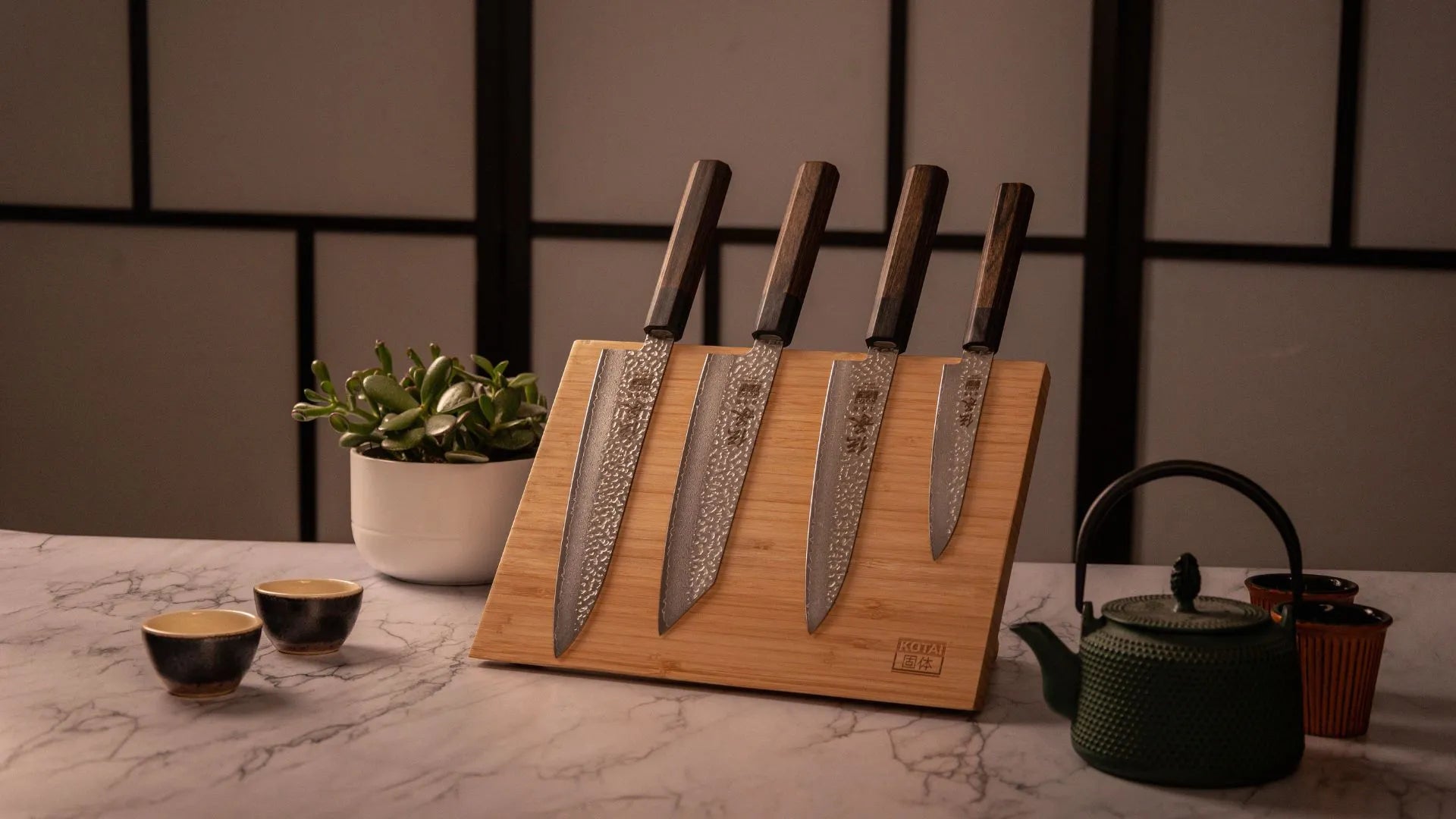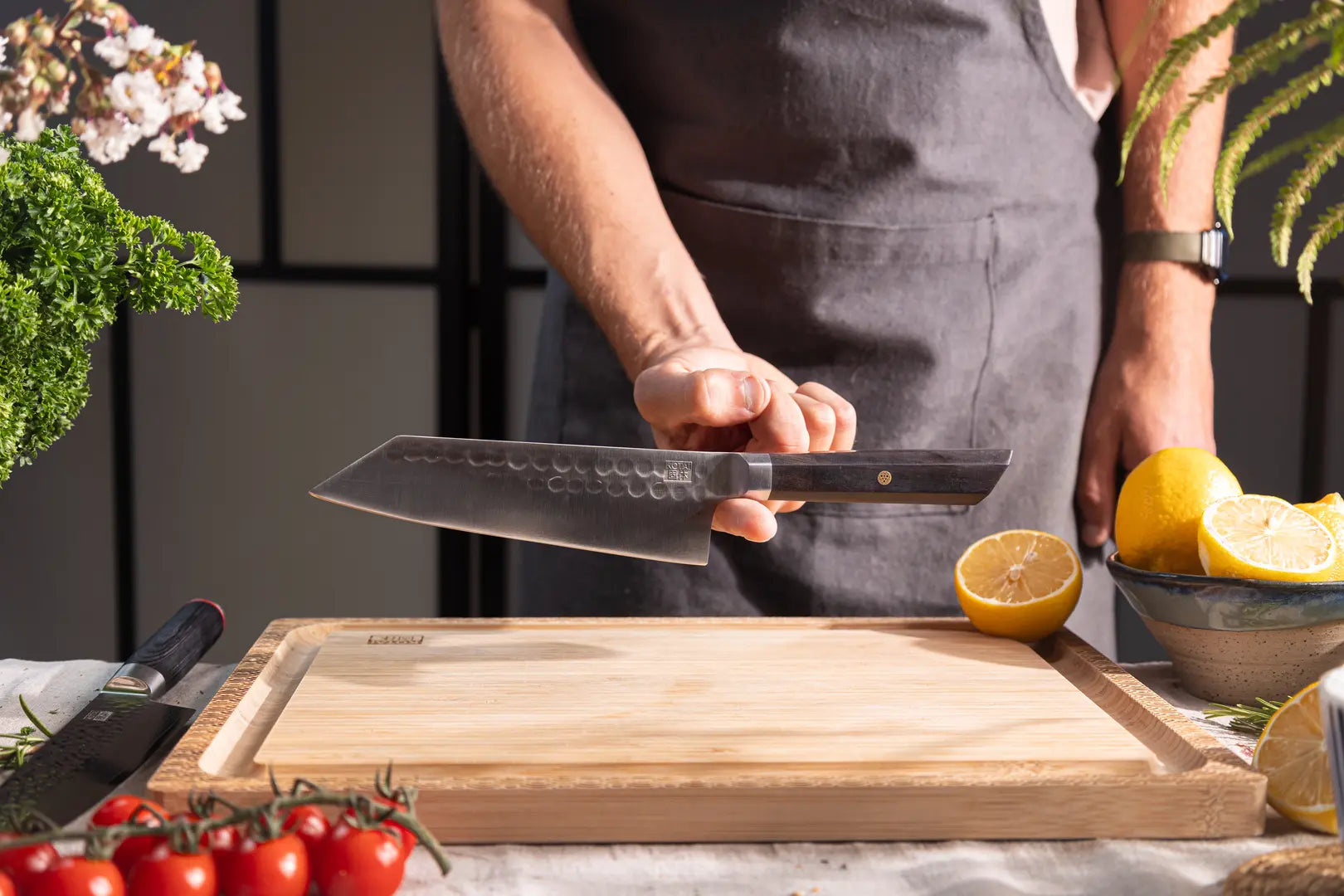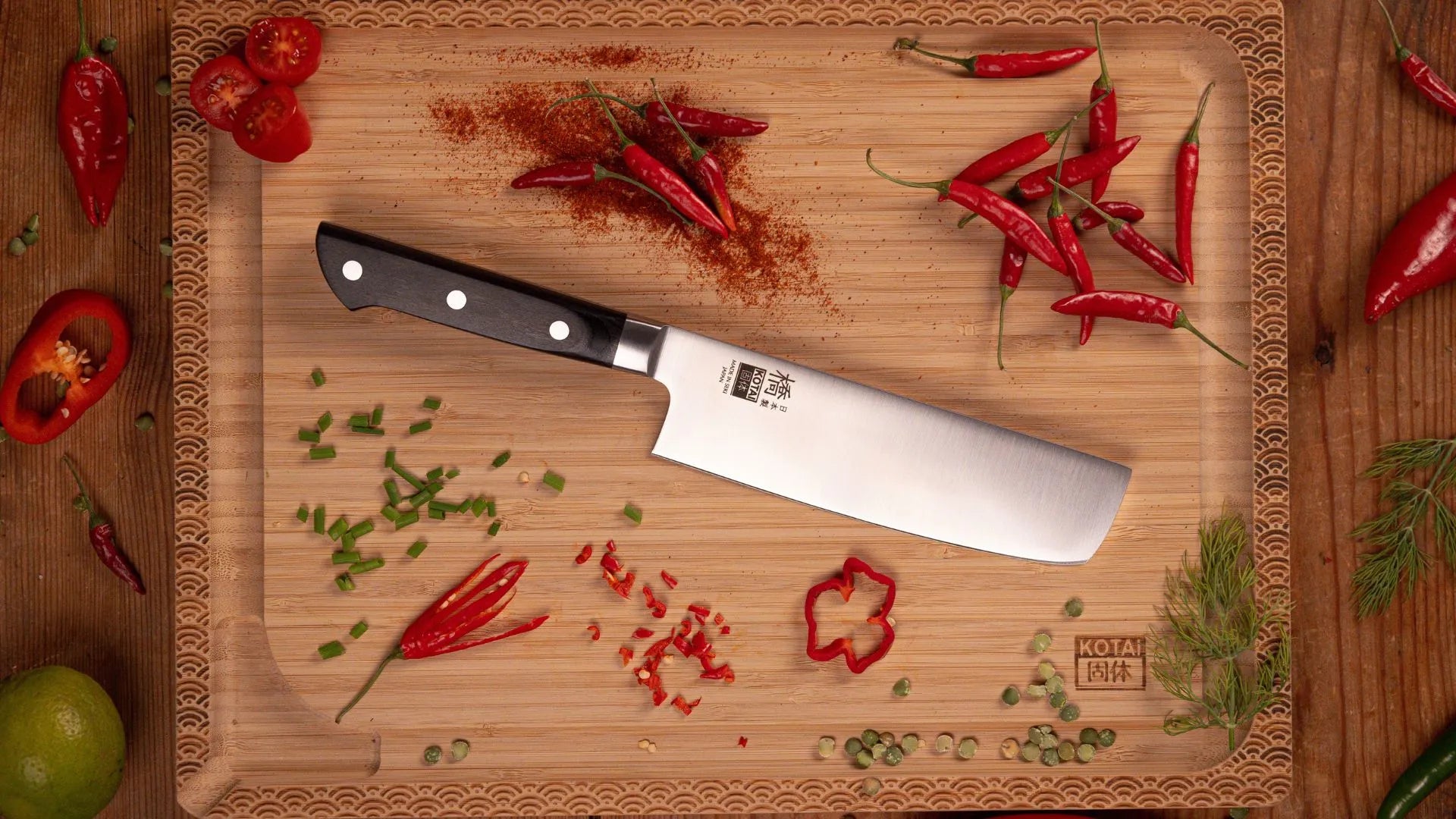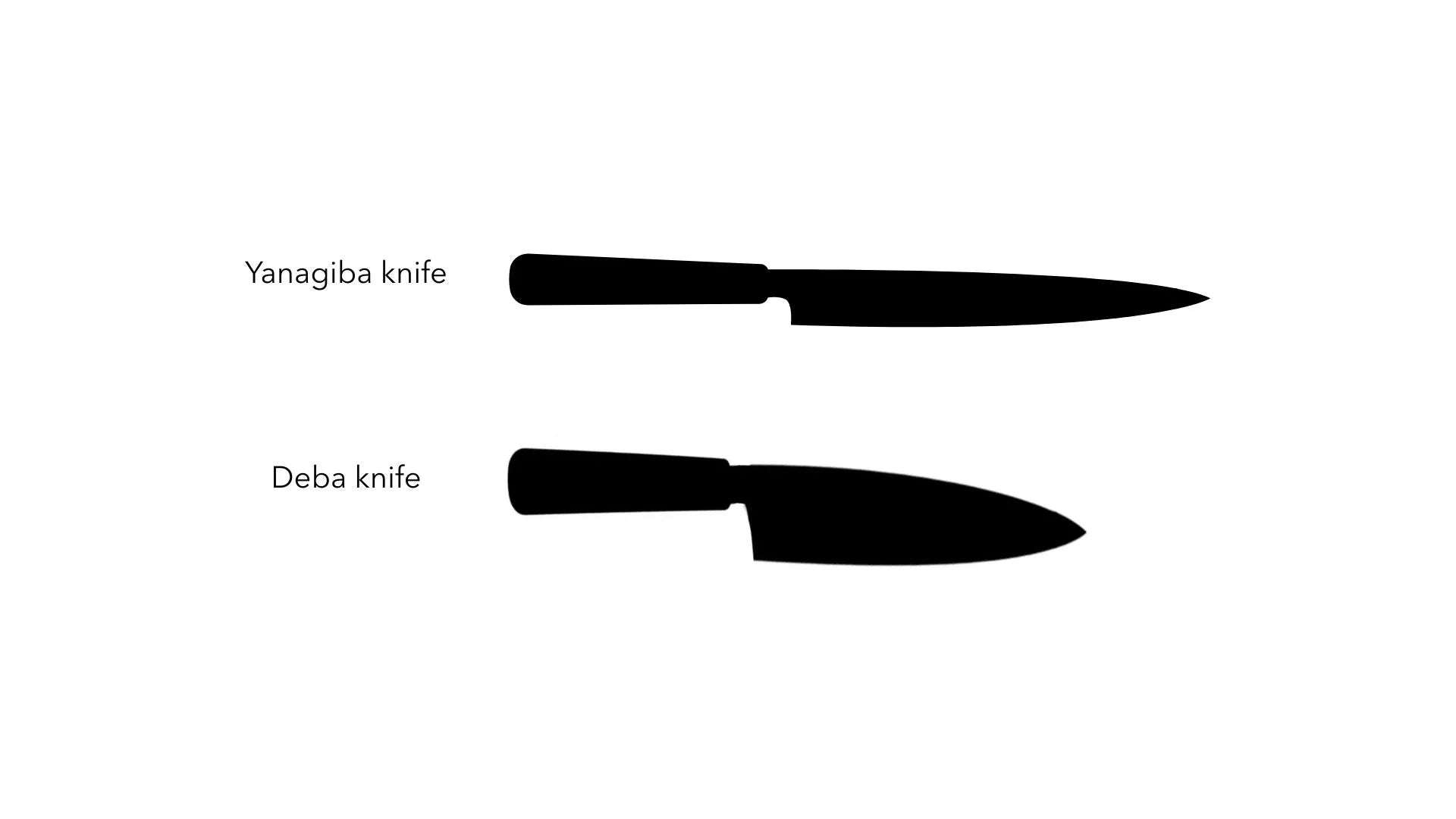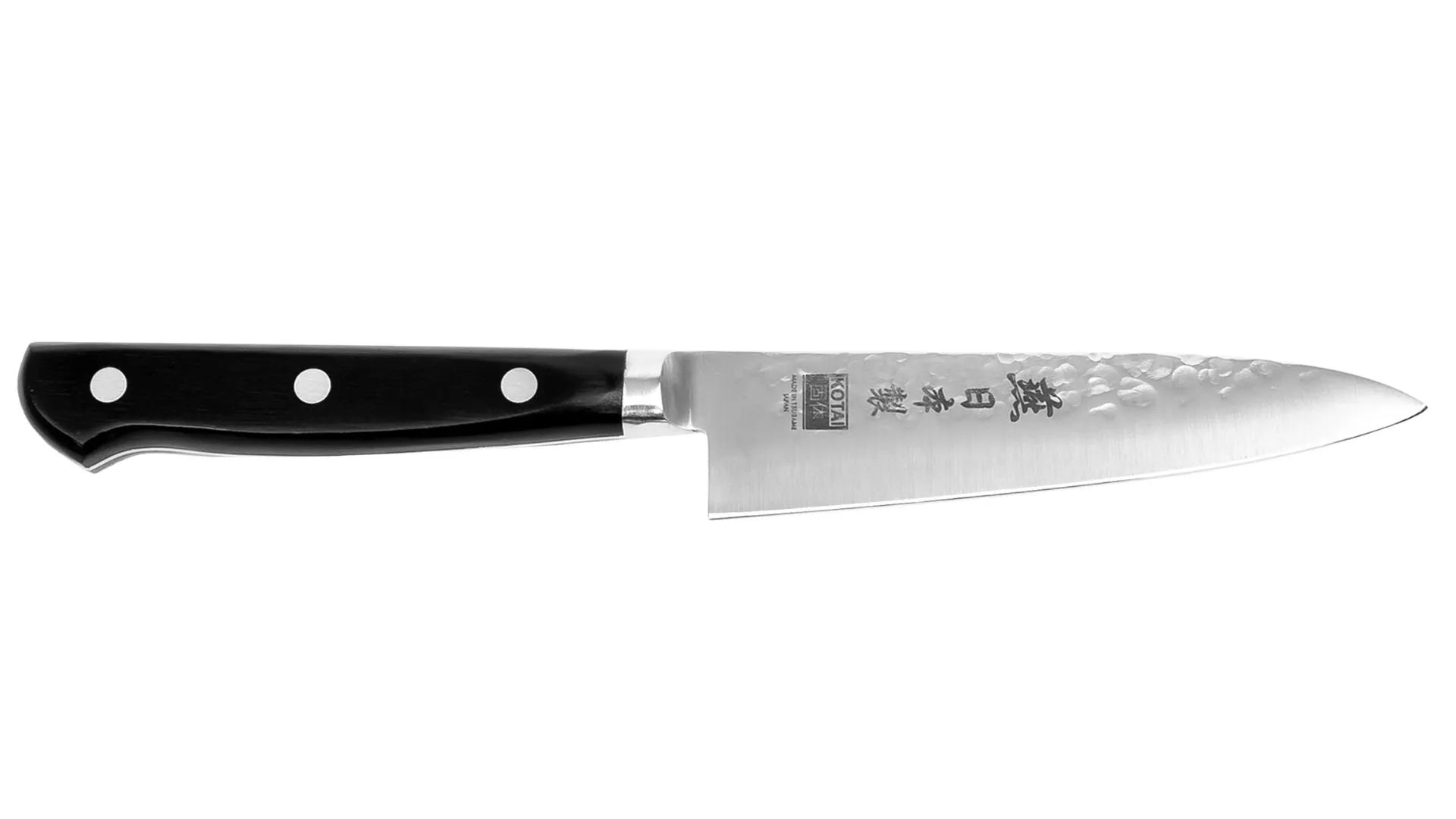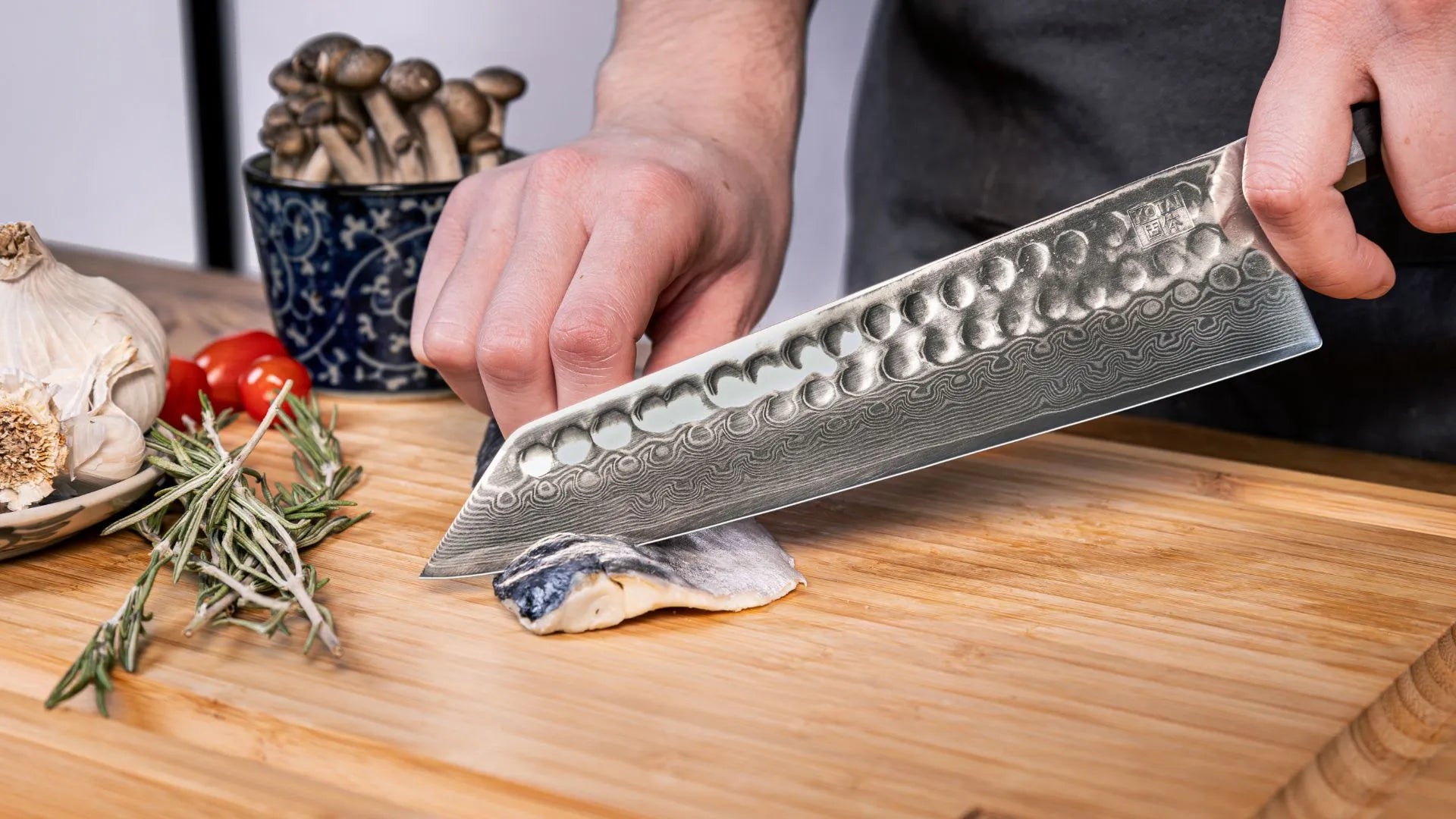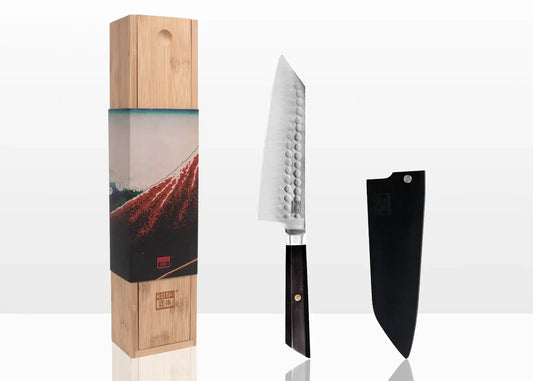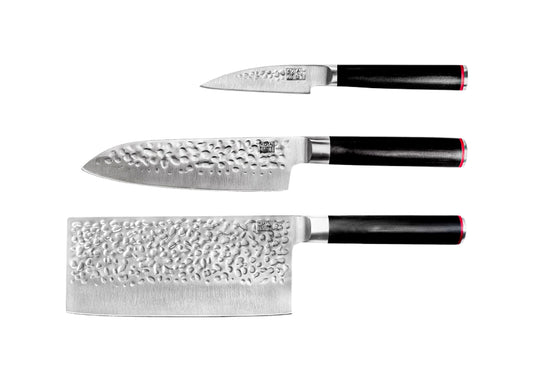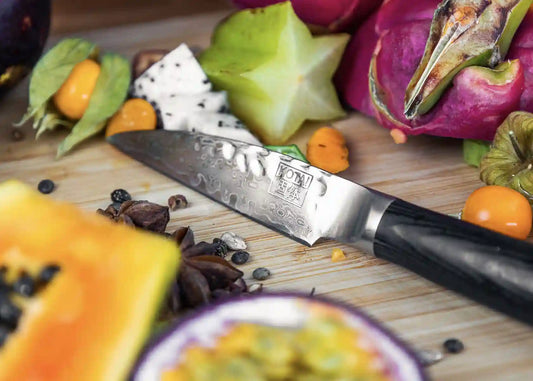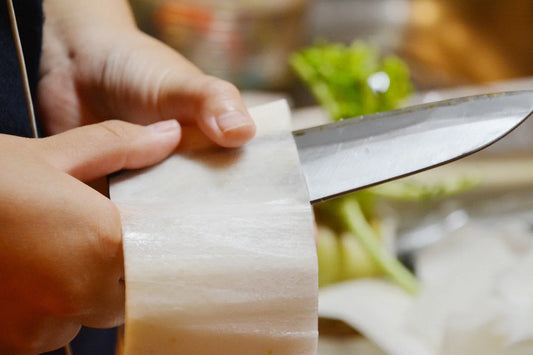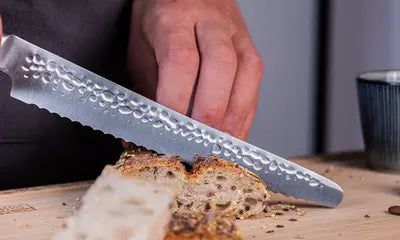Japanese knives stand out for their exceptional mastery of steel, blade geometry, and handle balance. From the surgical precision of slicing sashimi to the everyday cutting of vegetables, each model is designed for a specific purpose, combining efficiency with aesthetics. Understanding their differences makes it easier to choose the right tool, whether you are a home cook or a professional chef, and to fully appreciate the Japanese craftsmanship passed down through the centuries.
How Do Japanese Knives Stand Out?
Japanese knives are distinguished by a precise balance between cutting performance, material quality, and refined craftsmanship. Their reputation has spread all the way to Europe, where the Japanese santoku knife is among the most popular models. But how can you recognize a good Japanese knife? Several characteristics need to be considered: the composition of the steel, the type of sharpening, the handle construction, and the aesthetics.
The first major difference lies in the steel. VG-10 and AUS-10 are premium stainless steels that combine corrosion resistance with easy maintenance. They are among the most common choices for Damascus Japanese knives. Aogami and Shirogami both offer exceptional sharpness, although the latter is more prone to rust. The hardness of these steels, often above 60 HRC on the Rockwell scale, allows for thin, extremely sharp blades that are less forgiving to shocks. You can learn more about forging techniques on the website of the Japanese Traditional Culture Promotion & Development Organization.
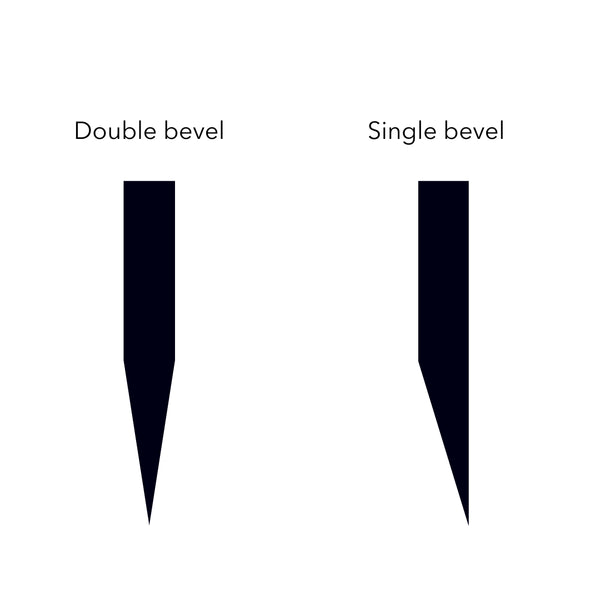
Next comes sharpening. Traditional Japanese knives often have a single bevel (kataba), sharpened on one side only, which creates a surgical cut ideal for preparing sashimi or slicing vegetables with precision. More versatile models feature a double bevel (ryoba), sharpened on both sides, easier to handle and closer to Western knives. The cutting angle, usually between 10° and 15° per side (compared to around 20° for a Western knife), explains the razor-sharp precision that has made Japanese blades so renowned.
Another notable difference is the tang. Western knives often feature a full tang, visible along the entire length of the handle, which provides uniform weight and rigidity. Traditional Japanese knives, on the other hand, usually use a half tang, where the steel of the blade extends only halfway into the handle, often a lightweight wa wooden handle. This construction shifts the balance point toward the blade, offering excellent maneuverability for precise cuts. It also makes it easy to replace the handle when worn out, a feature highly valued by professionals in Japan, though it remains a complex and relatively uncommon practice in Europe.
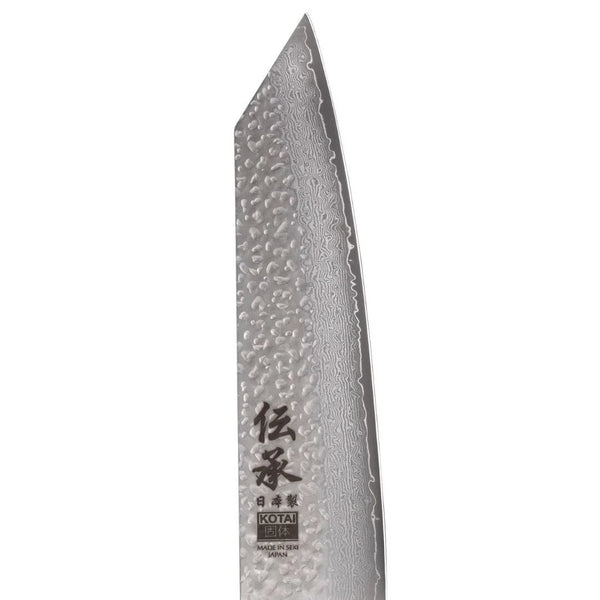
Finally, aesthetics and longevity should not be overlooked. Damascus patterns, created by layering steel, combine beauty with additional protection against corrosion. Traditional wa handles, often made of lightweight wood, provide a comfortable grip. With proper care, regular sharpening, and appropriate maintenance, a quality Japanese knife can last for decades, accompanying its user throughout their culinary journey.
→ See KOTAI’s Densho collection
Now that you understand the main characteristics of these knives, which type of Japanese knife should you choose? That will depend on your needs. There are specialized knives for cutting vegetables, fish, and precision tasks, as well as chef’s knives that are more versatile. Here are the most commonly used Japanese knives.
Knives for vegetables
What are the best Japanese knives for cutting vegetables? They are the usuba and the nakiri. Both are designed to make clean, straight cuts. Their wide and thin blades slice without crushing the fibers, preserving the texture and freshness of the food.
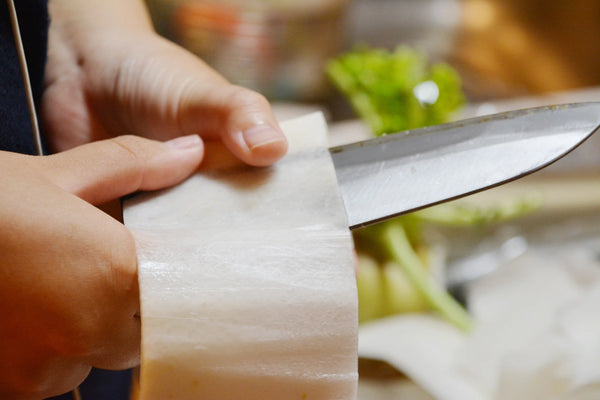
The usuba 薄刃包丁 is a traditional Japanese knife with a tall, flat blade, often featuring a single bevel (kataba). It appeared at the end of the Edo period and was used by professional chefs to execute refined cuts such as katsuramuki, an extremely fine ribbon-style peeling. Its height helps guide the blade along the joints of the fingers, while the flat edge makes perfectly straight cuts easier.
The nakiri is considered a domestic adaptation of the usuba. It keeps its rectangular shape but uses a double bevel (ryoba), making it more accessible to home cooks and ambidextrous users. Very popular in Japanese households from the 19th century onward, it became the go-to knife for chopping, slicing, or mincing all kinds of vegetables with precision and consistency.
Knives for fish
Fish preparation holds a central place in Japanese cuisine, and several specialized blades have been developed for each step of the process. What are the best Japanese knives for fish? The most commonly used are the yanagiba for slicing sashimi, the deba for filleting and cutting through bones, and the sujihiki and honesuki/garasuki for more specialized uses.
Long and narrow, the yanagiba 柳刃包丁 is the quintessential knife for slicing sashimi and sushi. Traditionally single-beveled (kataba), it is closely associated with professional sushi chefs. Regional variations include the takobiki in Tokyo and the fuguhiki for preparing fugu.
Robust and thick, the deba 出刃包丁 is used for filleting fish and cutting through the bones of a whole fish. Designed in Sakai during the Edo period to meet the growing demand for prepared fish, it combines a sharp single bevel with a heavy spine that helps cut through fine bones. It can also be used for certain poultry.
The sujihiki 筋引き and the honesuki 骨スキ are more specialized knives. The sujihiki, long and thin with a double bevel, is used for slicing both fish and meat with precision, creating clean cuts. The honesuki, triangular and agile, is ideal for deboning, especially poultry, and can also be used for certain fish or shellfish.
Precision knives
In cooking, some tasks require extreme precision: peeling, trimming, filleting small fish, or making decorative cuts. What are the best Japanese knives for precision work? The main ones are the petty and the ajikiri, both designed to offer maximum control.
The petty ペティナイフ, the Japanese equivalent of a paring knife, is small, handy, and versatile. Its 12 to 15 cm blade allows for precise work on fruits, vegetables, or small cuts of meat. It is almost always double-beveled (ryoba), which makes it easy to handle.
Designed for preparing small fish such as mackerel (aji in Japanese), the ajikiri 鯵切り包丁 has a short, tall blade that provides excellent control for filleting with precision. It can also be used for cutting small vegetables or performing fine decorative cuts.
Versatile knives
In modern Japanese cooking, some knives are designed to replace several tools at once. What are the best chef’s knives? The most iconic are the santoku, the gyuto, and, in a more prestigious category, the kiritsuke.
The santoku 三徳包丁 is arguably the most popular Japanese knife in the West. Its name literally means “three virtues” (meat, fish, vegetables), which reflects its versatile nature. Its short blade (16 to 18 cm) with a slightly straight profile makes it perfectly suited to home kitchens. It allows both push cuts and rocking motions. It is an excellent first Japanese knife, appreciated for its easy maintenance, versatility, and manageable size that reassures beginners.
→ See KOTAI’s 170 mm Bunka Santoku
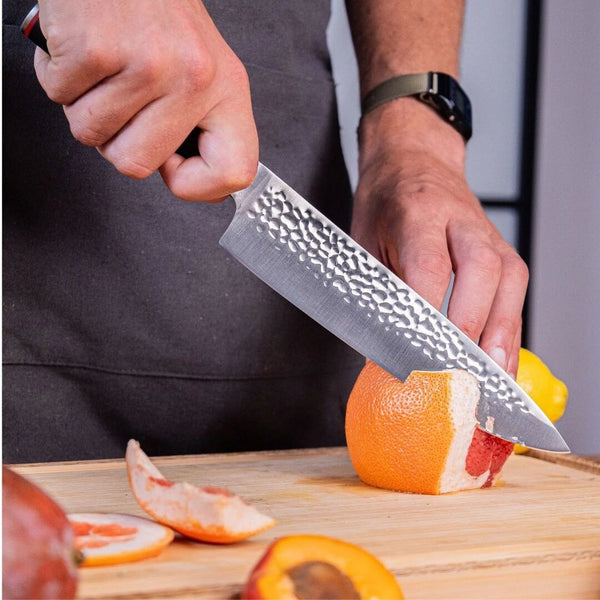
The gyuto 牛刀 is the Japanese equivalent of the Western chef’s knife. Its name literally means “beef knife,” as it was originally designed to meet the rising demand for meat in Japanese cuisine during the Meiji era (late 19th century). Longer than the santoku (20 to 24 cm), with a thinner blade and a sharp tip, the gyuto is suitable for both meat and vegetables. It is favored by professional chefs and enthusiasts who value clean, fast cuts, especially when working with large volumes of ingredients. The gyuto has become one of the most emblematic models of modern Japanese cutlery.
→ See KOTAI’s 200 mm Pakka Gyuto
The kiritsuke 切付包丁 is a prestigious knife reserved for experienced chefs. It is a hybrid between the usuba (for vegetables) and the yanagiba (for sashimi). Its characteristic angled tip provides excellent precision for fine cuts, while its length makes it suitable for slicing large pieces of fish or vegetables. Historically, the kiritsuke was a symbol of authority: in some traditions, only the head chef of a brigade was allowed to use it. Today, there are two versions: the traditional single-bevel (kataba), demanding and difficult to master, and the modern double-bevel (ryoba), more accessible and popular in the West, while retaining the knife’s original elegance. The kiritsuke remains associated with prestige, mastery, and culinary refinement.
KOTAI, the best of both worlds
Too often, cooks must choose between Japanese finesse and Western robustness. Why sacrifice precision for strength, or practicality for aesthetics? KOTAI proves that it is possible to have both: knives that combine the best of each tradition.
KOTAI has embraced what made Japanese knives legendary: premium high-carbon steels such as Damascus VG-10, Damascus AUS-10, and 440C, capable of holding a razor-sharp edge while resisting rust thanks to their high chromium content. Iconic shapes like the bunka, with its angular and versatile profile, or the tsuchime hammered finish, which combines artisanal beauty with practicality, naturally find their place in the collections. The 15° edge angle on each side, finer than the usual 20° in the West, ensures clean, precise, and effortless cuts.
On the Western side, KOTAI integrates the solidity and practicality that made German knives famous. The stainless blades withstand contact with acidic foods, provided they are cleaned promptly, which makes them easier to use on a daily basis. With the exception of the Densho (伝承 heritage) collection, the handles are built with a full tang construction, bringing balance and durability where traditional Japanese knives often rely on lighter half-tang handles. The result is a reliable tool that lasts for years without losing comfort or safety. And unlike traditional Japanese single-bevel knives (kataba), often reserved for experts, KOTAI opts for a double-bevel (ryoba) sharpening, more universal and intuitive. There is no need to be a sushi master to enjoy an exceptional edge.
How to Choose the Right Japanese Knife
Choosing the right Japanese knife depends on several factors. First, your level of experience. A beginner does not need an ultra-specialized knife, while an enthusiast or professional chef can make full use of blades designed for specific tasks and single-bevel edges. Next, consider the types of food you prepare. Fish, vegetables, or meat each have their standout knives. Budget is also important. It is better to invest in one or two high-quality versatile knives than to accumulate several mid-range blades. Finally, think about maintenance. Stainless steels like VG-10 or AUS-10 require less care, while carbon steels like Aogami or Shirogami offer an exceptional edge but need regular upkeep and careful attention to prevent rust.
To get started, KOTAI often recommends beginning with one or two versatile knives or a small basic set. This allows you to get familiar with Japanese blades without feeling overwhelmed.
-
Gyuto Chef Knife 200 mm - Pakka Collection
Regular price €120.00Regular priceUnit price per€160.00Sale price €120.00 -
Santoku Knife 170 mm - Bunka Collection
Regular price €120.00Regular priceUnit price per€160.00Sale price €120.00 -
Asian 3-Piece Knife Set - Pakka Collection
Regular price €310.00Regular priceUnit price per€430.00Sale price €310.00
Maintenance and Sharpening
To keep a Japanese knife performing at its best, proper maintenance is essential. The main tool is the whetstone, which allows for precise sharpening while keeping the correct angle of the edge. Microstones or finishing stones are used to polish the blade and correct any irregularities after the main sharpening. It is important to note that traditional single-bevel knives (kataba) require a more specific technique, since one side is flat and the other is sharpened.
→ See our sharpening tutorial
To extend the life of a Japanese knife, avoid the dishwasher, dry it immediately after washing, use a wooden or soft polyethylene cutting board, and sharpen regularly depending on usage. Even high-end stainless steels like VG-10 and AUS-10 need care to stay sharp and attractive over time.
Conclusion
Choosing a Japanese knife depends on how you plan to use it, your experience level, and your personal cooking style. From versatile knives to specialized blades, each model offers a unique balance of precision, control, and durability. Understanding the differences in steel, bevel, and shape makes it easier to select the right tool for your needs and fully enjoy the sharpness and efficiency of Japanese knives.
→ See all our knives
